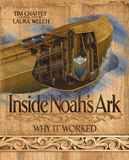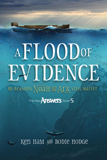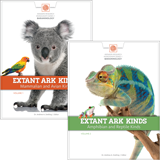
How Could All the Animals Fit on the Ark?
Abstract
One of the most important issues relating to the Bible’s flood account is the topic of animals on the ark. The estimated numbers, sizes, and types of ark animals impact nearly every aspect of the vessel’s interior operations, including time and labor expenditures, food and water needs, space and waste management, and enclosure design.1
The subject of fitting the required animals on the ark is a significant point of contention between biblical creationists and skeptics. However, properly addressing these concerns is more complicated than a mere compilation of data about different animal species. First, we must answer some fundamental questions.
How Large Was the Ark?
According to Genesis 6:15, the ark was 300 cubits long, 50 cubits wide, and 30 cubits high—the proportions of a genuine shipping vessel.
According to Genesis 6:15, the ark was 300 cubits long, 50 cubits wide, and 30 cubits high—the proportions of a genuine shipping vessel. A cubit is typically considered to be the length from a man’s furthest fingertip to his elbow. While various cubit lengths have been used throughout history, the Ark Encounter calculated the size of the ark based on a 20.4-inch (52 cm) cubit. The result is a vessel 510 feet (155 m) long, 85 feet (26 m) wide, and 51 feet (16 m) high. Accounting for a 15% reduction in volume due to the curvature of the hull, an ark this size could contain the equivalent of 450 semi-trailers of cargo or about 1.88 million cubic feet (53,200 m3)—a truly massive ship.
Which Animals Were Required on the Ark?
The Bible informs us that the ark housed representatives of every land-dependent, air-breathing animal—ones that could not otherwise survive the flood (Genesis 7:21–23). Conversely, Noah did not care for marine animals, and he probably did not need to bring insects, with the possible exception of delicate insects like butterflies and moths—since most insects could survive outside the ark. Also, insects take in oxygen through spiracles in their skin, and the Bible specifies that those creatures targeted outside of the ark were those “on the dry land in whose nostrils was the breath of life.”
How Many Species Are in the World Today?
Skeptics often assert that there are millions of species in the world— far more than the number that could fit on the ark. However, according to estimates published in 2014, there are fewer than 1.8 million documented species of organisms in the world. Consider also that over 98 percent of those species are fish, invertebrates, and non-animals (like plants and bacteria). This means that there are fewer than 34,000 species of known, land-dependent vertebrates in the world today.2
Species or Kinds?
Though wild animals today are often considered according to their species, the Bible deals with animals according to their min, a Hebrew word usually translated as “kind.” We can infer from Scripture that God created plants and animals to reproduce after their kinds (Genesis 1:11–25), and it is clear from various texts that a kind is often a broader category than the current concept of a species. This means that a kind may contain many different species. Since Noah was only sent select representatives from relevant kinds, all land-dwelling vertebrate species not present on the ark were wiped out. Therefore, if we see an ark kind represented today by different species (e.g., horses, zebras, and donkeys of the equid kind) those species have developed since the time of the flood. Therefore, species are simply varying expressions of a particular kind.
What Is an Animal Kind?
There are numerous approaches to defining a kind, but one of the simplest is a distinctly created type of organism and all descendants. Kinds are often referred to as baramins (from the Hebrew words for “created” and “kind”), and the study of created kinds is called baraminology.
What Are the Criteria for Identifying Kinds?
In 2011, Ark Encounter researchers began in-depth animal studies with the goal of identifying the maximum number of ark kinds.3 The researchers applied three primary criteria in estimating the ark kinds: hybridization, cognitum, and statistical baraminology.4
Hybrid data is the favored method in identifying kinds. Researchers believe that only closely related animals can successfully produce offspring, and this is consistent with the Bible’s emphasis on the relationship between reproduction and created kinds. Since only animals in the same kind are related, hybrids positively identify which animals are part of the same kind. The usefulness of hybrid data is limited, however, in that not all potential crosses have been tested or reliably documented, and some organisms have gone extinct. Hybridization is also strictly an inclusive criterion, as not even all related animals can produce offspring together (i.e., they have lost the ability to reproduce with certain others of their kind).
The cognitum approach estimates animal kinds using the human senses of perception. This method assumes that animal kinds have maintained their core distinctiveness even as they have diversified over time. Presently, extinct animals are most often classified using this approach. For example, woolly mammoths are extinct, and no hybrid data are connecting them with elephants. However, their extreme similarity to elephants has resulted in their assignment to the elephant kind.
In statistical analyses, continuities and discontinuities of animals are identified by comparing physical traits using statistical tests called baraminic distance correlation (BDC). Like the cognitum approach, this method assumes that the physical similarities and dissimilarities identified in the tests are reliable indicators of relatedness. It also assumes that the traits selected for comparison are baraminologically significant.
What Are Some Safeguards Against Underestimating the Number of Ark Animals?
The Ark Encounter researchers put several safeguards in place to avoid underestimating the number of animals on the ark. These include a tendency to “split” rather than “lump” animal groups. Also, all “clean” and all flying creatures—not just “clean” ones—were multiplied by fourteen instead of seven animals.
What Are Splitting and Lumping?
Estimating the number of animals on the ark depends upon several factors. Near the top of that list is the decision to split or lump the animals that may or may not be related as a kind.
Coyotes, wolves, dingoes, and domestic dogs can generally interbreed. Thus, they can be lumped into the same kind. So, Noah just needed two members of the dog kind on the ark.
On the other hand, there are approximately two dozen known families of bats, living and extinct. Based on anatomy and other features, many of these families probably belong to the same kind (e.g., if we used the cognitum criteria). In fact, it is possible that every bat belongs to the same kind. However, since breeding studies have not yet confirmed this idea, the Ark Encounter researchers split the bats into their various families. So instead of including as few as 14 bats on the ark, the team accounted for over 300 of them (14 from each family). In keeping with the worst-case approach to estimating the number of animals on the ark, the animals were split into separate kinds whenever the data was insufficient to support lumping them into a single kind.
Why Fourteen Instead of Seven?
Some Bible translations indicate that Noah was to bring seven of each flying creature and clean animal. Yet other Bible translations state that seven pairs of these creatures were on the ark.
| Seven of Each Kind | Seven Pairs of Each Kind |
|---|---|
| KJV* NKJV NASB* NET* NIV (1984)* |
NLT ESV* HCSB NRSV NIV (2011) |
The Hebrew text literally reads, “seven seven—a male and his female” (Genesis 7:2). Does this unique phrasing mean seven or fourteen?
In favor of the “seven” view is that Genesis 8:20 states that Noah sacrificed clean animals and birds after the flood. While it doesn’t say that Noah sacrificed just one animal of each clean kind, those who hold to the “seven” view could point to the common “six and one” pattern seen in the Old Testament. For example, God created the world in six days and rested for one (Genesis 1; Exodus 20:11). Perhaps six of each clean animal were for man’s use, and one was dedicated to the Lord.
In favor of the “seven pairs” view is the text’s mention that there would be a male and “his female” for the clean animals. If an odd number was brought to Noah, then plenty of animals did not have a mate. Furthermore, the Hebrew text does not use similar wording with the unclean animals in verse two. That is, readers can know that one pair of unclean animals was in view, but the text does not say “two two, a male and his female.” It just has the word for two.
Since Hebrew language scholars do not agree about this issue, it seems wise to be tentative about which view is accurate. Since a worst-case approach is being used regarding the animals, these calculations are based on the “seven pairs” position.
What Is Meant by a “Worst-Case Scenario?”
The Ark Encounter depicts a worst-case approach when estimating the number of animal kinds. Some people believe Noah brought two of every unclean animal and seven of every clean animal. The text seems to indicate that Noah cared for more animals than this (Genesis 7:2–3), particularly when it comes to the clean animals and flying creatures. The Lord may have sent seven pairs of the clean animals and seven pairs of all the flying creatures (not just the clean varieties).
Although this worst-case approach more than doubles the total estimated number of animals on the ark, this model shows that even a high-end estimate of total animals would have fit on board. Obviously, if the Lord sent just seven of each clean animal and seven of just the clean flying creatures, the ark would have had plenty of space to accommodate this lower total.
How Big Were the Ark Animals?
People often wonder how all the animals could have fit in the ark, particularly when considering the massive dinosaurs. We see so many illustrations of large creatures packed tightly into a little boat. But this image is inaccurate. Noah’s ark was much larger than it is usually depicted, and many of the animals were probably smaller than shown in popular pictures.
Noah’s ark was much larger than it is usually depicted, and many of the animals were probably smaller than shown in popular pictures.
It makes more sense to think that God would have sent to Noah juveniles or smaller varieties within the same kind. Consider the following advantages of bringing juveniles or smaller versions of a creature:
- They take up less space.
- They eat less.
- They create less waste.
- They are often easier to manage.
- They are generally more resilient.
- In the case of juveniles, they would have more time to reproduce after the flood.
Indeed, even when the giant dinosaurs and elephant-sized creatures are factored in, the ark animals were probably much smaller than is frequently assumed. According to Ark Encounter estimates, it is projected only 15 percent of ark animals would have achieved an average adult mass over 22 pounds (10 kg). This means that the vast majority of ark animals were smaller than a beagle, with most of those being much smaller. Starting with a mass category of 0.035–0.35 oz. (1–10 g), the animal groups were distributed into eight logarithmically increasing size classes. Amazingly, the size range with the highest projected number of ark animals was 0.35–3.5 oz. (10–100 g).
How Many Animal Kinds and Individuals Were on the Ark?
Based on initial projections, the Ark Encounter team estimates that there were around 1,400 animal kinds on the ark. It is anticipated that future research may reduce that number even further.
The Ark Encounter team projects that there were fewer than 7,000 animals on board the ark. The wide discrepancy between the number of ark kinds and individuals is due to the relatively large number of flying and “clean” kinds—each estimated at 14 animals apiece.
| Extinct Groups | Kinds (est.) | Per Kind | Total Animals (est.) |
|---|---|---|---|
| Amphibians | 54 | 2 | 108 |
| Reptiles | 219 | Flying: 24 x 14 = 336 Flightless: 195 x 2 = 390 |
726 |
| Non-Mammalian Synapsids | 78 | 2 | 156 |
| Mammals | 332 | Clean/Flying: 15 x 14 = 210 Unclean: 317 x 2 = 634 |
844 |
| Birds | 89 | Flying: 69 x 14 = 966 Flightless: 20 x 2 = 40 |
1,006 |
| Living Groups | Kinds (est.) | Per Kind | Total Animals (est.) |
| Amphibians | 194 | 2 | 388 |
| Reptiles | 101 | 2 | 202 |
| Mammals | 136 | Clean/Flying: 31 x 14 = 434 Unclean: 105 x 2 = 210 |
644 |
| Birds | 195 | Flying: 190 x 14 = 2,660 Flightless: 5 x 2 = 10 |
2,670 |
| Total | 1,398 | 6,744 |
Conclusion
It is worth noting that the numbers included here are only initial estimates drawn from currently available information. On the other hand, a hypothetical 3D-digital ark created by the Ark Encounter design team, complete with all enclosures, interior structural elements, food, and water storage, showed that everything fit extremely well with little space left over.
Just as Noah trusted God concerning unseen things, so too should we trust God in the things we cannot witness.
In the end, the most important reason to believe that all the right animals fit has nothing to do with spreadsheets and 3D models—as helpful as they can sometimes be. We find this reason in Hebrews 11:7, where the writer says, “By faith Noah, being warned by God concerning events as yet unseen, in reverent fear constructed an ark for the saving of his household. By this he condemned the world and became an heir of the righteousness that comes by faith.” Just as Noah trusted God concerning unseen things, so too should we trust God in the things we cannot witness. Since God provided both the ark specifications and the creatures sustained within the vessel (Genesis 6:20), we can know just as surely as Noah that they all fit and were spared the watery judgment.
Answers in Depth
2019 Volume 14
Answers in Depth explores the biblical worldview in addressing modern scientific research, history, current events, popular media, theology, and much more.
Browse VolumeFootnotes
- See Inside Noah’s Ark: Why It Worked, ed. Laura Welch (Green Forest, AR: Master Books, 2016).
- IUCN 2014. IUCN Red List of Threatened Species. Version 2014.2.
. Downloaded on 9 November 2016. See the following articles:
- Jean Lightner, “Mammalian Ark Kinds,” Answers Research Journal 5 (October 31, 2012): https://answersingenesis.org/creation-science/baraminology/mammalian-ark-kinds/.
- Tom Hennigan, “An Initial Estimate Toward Identifying and Numbering Amphibian Kinds within the Orders Caudata and Gymnophiona,” Answers Research Journal 6 (January 23, 2013): https://answersingenesis.org/creation-science/baraminology/identifying-and-numbering-amphibian-kinds-results/.
- Tom Hennigan, “An Initial Estimate toward Identifying and Numbering the Frog Kinds on the Ark: Order Anura,” Answers Research Journal 6 (October 2, 2013): https://answersingenesis.org/creation-science/baraminology/an-initial-estimate-toward-identifying-and-numbering-the-frog-kinds-on-the-ark-order-anura/.
- Jean Lightner, “An Initial Estimate of Avian Ark Kinds,” Answers Research Journal 6 (November 27, 2013): https://answersingenesis.org/creation-science/baraminology/an-initial-estimate-of-avian-ark-kinds/.
- Tom Hennigan, “An Initial Estimate toward Identifying and Numbering the Ark Turtle and Crocodile Kinds,” Answers Research Journal 7 (January 8, 2014): https://answersingenesis.org/creation-science/baraminology/an-initial-estimate-toward-identifying-and-numbering-the-ark-turtle-and-crocodile-kinds/.
- Tom Hennigan, “An Initial Estimate toward Identifying and Numbering Extant Tuatara, Amphisbaena, and Snake Kinds,” Answers Research Journal 7 (February 19, 2014): https://answersingenesis.org/creation-science/baraminology/an-initial-estimate-toward-identifying-and-numbering-extant-tuatara-amphisbaena-and-snake-kinds/.
- Marcus Ross, “Fossil Baramins on Noah’s Ark: The ‘Amphibians’,” Answers Research Journal 7 (September 17, 2014): https://answersingenesis.org/creation-science/baraminology/fossil-baramins-noahs-ark-amphibians/.
- Tom Hennigan, “An Initial Estimation of the Numbers and Identification of Extant Non-Snake/Non-Amphisbaenian Lizard Kinds: Order Squamata,” Answers Research Journal 8 (April 8, 2015): https://answersingenesis.org/creation-science/baraminology/initial-estimation-numbers-and-identification-of-order-squamata/.
- These last two methods are admittedly subjective and play off the assumption of common design indicating common ancestry within a kind. Even though these methods are utilized, the results are seen as highly tentative since they have proven inaccurate in certain instances. But due to the limited amount of hybridization data, these are presently our best alternatives.
Recommended Resources

Answers in Genesis is an apologetics ministry, dedicated to helping Christians defend their faith and proclaim the good news of Jesus Christ.
- Customer Service 800.778.3390
- © 2024 Answers in Genesis





